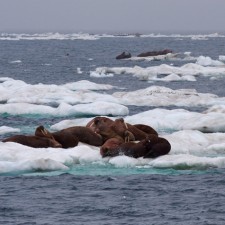Acoustic Sensing
Remote Sensing with Sound
Acoustics is a key component of ocean observation at all scales. This is a result of the rapid attenuation of optical and electromagnetic waves in water that renders useless in the oceans most of the primary remote sensing tools we use in the atmosphere and in space.
Acoustic waves, on the other hand, can travel great distances underwater. They provide the primary mechanism for remote sensing in the ocean by mankind and many marine creatures. Applications of faculty research range from climate studies and oceanographic sensing to studying the effects of sound on marine mammals.
Together MIT and WHOI have arguably the highest concentration of expertise in ocean acoustics in the world, including dozens of the world’s leading scientists, engineers, and technical staff.
The Science and Engineering of Underwater Sound
MIT has a strong tradition in the science of underwater sound and the development of the technology exploiting it. During the Cold War, engineers at MIT and WHOI pioneered the development of numerical models for sound propagation in the ice-covered Arctic ocean.
Since the end of the Cold War, we have expanded the breadth of our programs with increasing emphasis on environmental sensing and the development of communication and navigation infrastructure technology for unmanned, distributed networks.
Acoustic Sensing, Modeling, and Communication
Unmanned underwater networks are rapidly becoming the dominant platforms for undersea observation and monitoring systems. A major part of our research effort now concerns the development of environmentally adaptive autonomy in support of acoustic sensing.
Our programs are closely linked to the development of intelligence for such networks. These include exploring autonomous behaviors using on-board modeling and simulation of the acoustic environment for maneuvering sensing platforms into positions that are optimal for acoustic sensing or for communication with other devices.
We also have created major programs in the use of acoustics for mapping oceanographic and biological ocean processes. Applications include the assessment of environmental features such as fish school distributions and tagging marine mammals.
Key Technology Developments
- Acoustic sensing of population distributions and behavior of fish, whales, and plankton.
- Acoustic tagging of marine life to study the behavior of endangered and keystone species of the ocean ecosystem.
- Long-range low frequency acoustic thermometry to measure global warming in the oceans.
- Acoustic quantification of air-sea mixing and material exchange.
- Acoustic measurements of polar pack ice thickness as well as glacier and ice-sheet stability.
- Underwater acoustic communications and sensing to facilitate human and robot access to and habitation of the marine environment.







